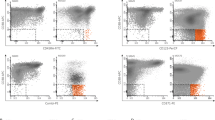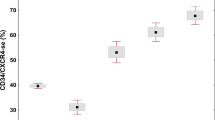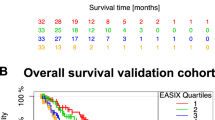Abstract
Circulating endothelial cells (CECs) are associated with neoangiogenesis in various malignant disorders. Using flow cytometry, we studied CECs in 128 patients with myelodysplastic syndrome (MDS). MDS patients had higher CEC levels than controls (P<0.001), and an inverse relationship was found between CECs and international prognostic scoring system risk (r=−0.55, P<0.001). There was a positive correlation between marrow microvessel density and CECs, low-risk patients showing the strongest association (r=0.62, P<0.001). We calculated a progenitor-to-mature CEC ratio, which was higher in MDS patients than in healthy subjects (P<0.001), the highest values were found at diagnosis. CECs assessed by flow cytometry positively correlated with the ability to produce endothelial colony-forming cells in vitro (ECFCs; r=0.57, P=0.021), which was significantly higher in MDS patients than in controls (P=0.011). Fluorescence in situ hybridization analysis showed that a variable proportion of CECs (from 40 to 84%) carried the same chromosomal aberration as the neoplastic clone, while endothelial cells isolated from in vitro assays were negative. This study suggests that CECs reflect the abnormal angiogenesis found in MDS, especially in the early stages of the disease. The increased number of functional endothelial progenitor cells in MDS strengthens the rationale for therapeutic interventions aimed at restoring a normal interaction between hematopoietic progenitors and marrow microenvironment.
This is a preview of subscription content, access via your institution
Access options
Subscribe to this journal
Receive 12 print issues and online access
$259.00 per year
only $21.58 per issue
Buy this article
- Purchase on Springer Link
- Instant access to full article PDF
Prices may be subject to local taxes which are calculated during checkout




Similar content being viewed by others
References
Carmeliet P . Angiogenesis in health and disease. Nat Med 2003; 9: 653–660.
Carmeliet P, Jain RK . Angiogenesis in cancer and other diseases. Nature 2000; 407: 249–257.
Streubel B, Chott A, Huber D, Exner M, Jager U, Wagner O et al. Lymphoma-specific genetic aberrations in microvascular endothelial cells in B-cell lymphomas. N Engl J Med 2004; 351: 250–259.
Peters BA, Diaz LA, Polyak K, Meszler L, Romans K, Guinan EC et al. Contribution of bone marrow-derived endothelial cells to human tumor vasculature. Nat Med 2005; 11: 261–262.
Lyden D, Hattori K, Dias S, Costa C, Blaikie P, Butros L et al. Impaired recruitment of bone-marrow-derived endothelial and hematopoietic precursor cells blocks tumor angiogenesis and growth. Nat Med 2001; 7: 1194–1201.
Mancuso P, Burlini A, Pruneri G, Goldhirsch A, Martinelli G, Bertolini F . Resting and activated endothelial cells are increased in the peripheral blood of cancer patients. Blood 2001; 97: 3658–3661.
Beerepoot LV, Mehra N, Vermaat JS, Zonnenberg BA, Gebbink MF, Voest EE . Increased levels of viable circulating endothelial cells are an indicator of progressive disease in cancer patients. Ann Oncol 2004; 15: 139–145.
Zhang H, Vakil V, Braunstein M, Smith EL, Maroney J, Chen L et al. Circulating endothelial progenitor cells in multiple myeloma: implications and significance. Blood 2005; 105: 3286–3294.
Rigolin GM, Fraulini C, Ciccone M, Mauro E, Bugli AM, De Angeli C et al. Neoplastic circulating endothelial cells in multiple myeloma with 13q14 deletion. Blood 2006; 107: 2531–2535.
Fang B, Zheng C, Liao L, Han Q, Sun Z, Jiang X et al. Identification of human chronic myelogenous leukemia progenitor cells with hemangioblastic characteristics. Blood 2005; 105: 2733–2740.
Cazzola M, Malcovati L . Myelodysplastic syndromes—coping with ineffective hematopoiesis. N Engl J Med 2005; 352: 536–538.
Pellagatti A, Cazzola M, Giagounidis AA, Malcovati L, Della Porta MG, Killick S et al. Gene expression profiles of CD34+ cells in myelodysplastic syndromes: involvement of interferon stimulated genes and correlation to FAB subtype and karyotype. Blood 2006; 108: 337–345.
Rosenfeld C, List A . A hypothesis for the pathogenesis of myelodysplastic syndromes: implications for new therapies. Leukemia 2000; 14: 2–8.
Aguayo A, Kantarjian H, Manshouri T, Gidel C, Estey E, Thomas D et al. Angiogenesis in acute and chronic leukemias and myelodysplastic syndromes. Blood 2000; 96: 2240–2245.
Korkolopoulou P, Apostolidou E, Pavlopoulos PM, Kavantzas N, Vyniou N, Thymara I et al. Prognostic evaluation of the microvascular network in myelodysplastic syndromes. Leukemia 2001; 15: 1369–1376.
Cortelezzi A, Fracchiolla NS, Mazzeo LM, Silvestris I, Pomati M, Somalvico F et al. Endothelial precursors and mature endothelial cells are increased in the peripheral blood of myelodysplastic syndromes. Leuk Lymphoma 2005; 46: 1345–1351.
Vardiman JW, Harris NL, Brunning RD . The World Health Organization (WHO) classification of the myeloid neoplasms. Blood 2002; 100: 2292–2302.
Malcovati L, Della Porta MG, Pascutto C, Invernizzi R, Boni M, Travaglino E et al. Prognostic factors and life expectancy in myelodysplastic syndromes classified according to WHO criteria: a basis for clinical decision making. J Clin Oncol 2005; 23: 7594–7603.
Greenberg P, Cox C, LeBeau MM, Fenaux P, Morel P, Sanz G et al. International scoring system for evaluating prognosis in myelodysplastic syndromes. Blood 1997; 89: 2079–2088.
Stelzer GT, Marti G, Hurley A, McCoy Jr P, Lovett EJ, Schwartz A . U.S.–Canadian Consensus recommendations on the immunophenotypic analysis of hematologic neoplasia by flow cytometry: standardization and validation of laboratory procedures. Cytometry 1997; 30: 214–230.
Khan SS, Solomon MA, McCoy Jr JP . Detection of circulating endothelial cells and endothelial progenitor cells by flow cytometry. Cytometry B Clin Cytom 2005; 64: 1–8.
Bardin N, George F, Mutin M, Brisson C, Horschowski N, Frances V et al. S-Endo 1, a pan-endothelial monoclonal antibody recognizing a novel human endothelial antigen. Tissue Antigens 1996; 48: 531–539.
Peichev M, Naiyer AJ, Pereira D, Zhu Z, Lane WJ, Williams M et al. Expression of VEGFR-2 and AC133 by circulating human CD34(+) cells identifies a population of functional endothelial precursors. Blood 2000; 95: 952–958.
Woywodt A, Blann AD, Kirsch T, Erdbruegger U, Banzet N, Haubitz M et al. Isolation and enumeration of circulating endothelial cells by immunomagnetic isolation: proposal of a definition and a consensus protocol. J Thromb Haemost 2006; 4: 671–677.
Asahara T, Murohara T, Sullivan A, Silver M, van der Zee R, Li T et al. Isolation of putative progenitor endothelial cells for angiogenesis. Science 1997; 275: 964–967.
Ingram DA, Mead LE, Tanaka H, Meade V, Fenoglio A, Mortell K et al. Identification of a novel hierarchy of endothelial progenitor cells using human peripheral and umbilical cord blood. Blood 2004; 104: 2752–2760.
Valgimigli M, Rigolin GM, Fucili A, Della Porta MG, Soukhomovskaia O, Malagutti P et al. CD34+ and endothelial progenitor cells in patients with various degrees of congestive heart failure. Circulation 2004; 110: 1209–1212.
Massa M, Rosti V, Ferrario M, Campanelli R, Ramajoli I, Rosso R et al. Increased circulating hematopoietic and endothelial progenitor cells in the early phase of acute myocardial infarction. Blood 2005; 105: 199–206.
List A, Kurtin S, Roe DJ, Buresh A, Mahadevan D, Fuchs D et al. Efficacy of lenalidomide in myelodysplastic syndromes. N Engl J Med 2005; 352: 549–557.
Ingram DA, Caplice NM, Yoder MC . Unresolved questions, changing definitions, and novel paradigms for defining endothelial progenitor cells. Blood 2005; 106: 1525–1531.
Yoder MC, Mead LE, Prater D, Krier TR, Mroueh KN, Li F et al. Redefining endothelial progenitor cells via clonal analysis and hematopoietic stem/progenitor cell principals. Blood 2007; 109: 1801–1809.
Ruiz de Almodovar C, Luttun A, Carmeliet P . An SDF-1 trap for myeloid cells stimulates angiogenesis. Cell 2006; 124: 18–21.
Case J, Mead LE, Bessler WK, Prater D, White HA, Saadatzadeh MR et al. Human CD34+AC133+VEGFR-2+ cells are not endothelial progenitor cells but distinct, primitive hematopoietic progenitors. Exp Hematol 2007; 35: 1109–1118.
Hendrix MJ, Seftor EA, Hess AR, Seftor RE . Vasculogenic mimicry and tumour-cell plasticity: lessons from melanoma. Nat Rev Cancer 2003; 3: 411–421.
Yoon CH, Hur J, Park KW, Kim JH, Lee CS, Oh IY et al. Synergistic neovascularization by mixed transplantation of early endothelial progenitor cells and late outgrowth endothelial cells: the role of angiogenic cytokines and matrix metalloproteinases. Circulation 2005; 112: 1618–1627.
Grunewald M, Avraham I, Dor Y, Bachar-Lustig E, Itin A, Jung S et al. VEGF-induced adult neovascularization: recruitment, retention, and role of accessory cells. Cell 2006; 124: 175–189.
Okamoto R, Ueno M, Yamada Y, Takahashi N, Sano H, Suda T et al. Hematopoietic cells regulate the angiogenic switch during tumorigenesis. Blood 2005; 105: 2757–2763.
Acknowledgements
This study was supported by grants from Fondazione Cariplo, Milan, Italy; Associazione Italiana per la Ricerca sul Cancro (AIRC), Milan, Italy; Fondazione Ferrata Storti, Pavia, Italy; and Fondazione IRCCS Policlinico San Matteo, Pavia, Italy.
Author information
Authors and Affiliations
Corresponding author
Rights and permissions
About this article
Cite this article
Della Porta, M., Malcovati, L., Rigolin, G. et al. Immunophenotypic, cytogenetic and functional characterization of circulating endothelial cells in myelodysplastic syndromes. Leukemia 22, 530–537 (2008). https://doi.org/10.1038/sj.leu.2405069
Received:
Revised:
Accepted:
Published:
Issue Date:
DOI: https://doi.org/10.1038/sj.leu.2405069
Keywords
This article is cited by
-
Dysfunctional bone marrow endothelial progenitor cells are involved in patients with myelodysplastic syndromes
Journal of Translational Medicine (2022)
-
Decision analysis of allogeneic hematopoietic stem cell transplantation for patients with myelodysplastic syndrome stratified according to the revised International Prognostic Scoring System
Leukemia (2017)
-
Contribution of bone microenvironment to leukemogenesis and leukemia progression
Leukemia (2009)



